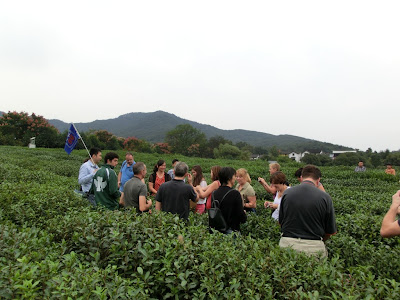 |
| Tea Bushes |
One of the most famous, if not the most famous, teas in China comes Hangzhou.....from the hills surrounding the West Lake. LongJingCha, it is called. It is a green tea. Translated, it is known as Dragon Well tea to English speakers. In the old days, the best of this tea was reserved for the emperors. Today, much of the high quality stuff is still reserved for government use. Good quality LongJing tea can be expensive. The highest quality can be obscenely expensive. For that reason, Dragon Well Tea is also one of the most counterfeited items in the country.
 |
| Gathering Tea Leaves |
 |
| More gathering of tea leaves |
The secret of good green tea, we learned, is in the roasting of the leaves. The roasting of the leaves assures quick drying, but more importantly it denatures the natural enzymes in the leaves. If you just pick the leaves and allow them to dry in the air, then the colors will darken and the flavor will become less flowery and more earthy. This is how the dark teas (like the stuff in the tea bag) are made. If you roast the fresh picked leaves quickly and carefully, then it stops the oxidation processes dead in their tracks. The leaves dry, but they retain their green color and their herb-like scents.
 |
| Pan roasting the leaves - the essential step |
So, at first this whole tea plantation thing seemed a bit touristy and hokey. In time, though, it was explained that this really WAS a working tea plantation, and not some Disneyland stagecraft. The guides and the pan roasters really WERE tea growers and not people play acting the role. The land, like all the land in China, is owned by the government. The government grants the use of the land to the farmer. It's like sharecropping. Sharecropping has never been a particularly lucrative occupation.
This particular farm family makes most of their income by producing tea. The whole tourist thing is just a way to bring in a little cash on the side. It also gives them a chance to sell their product directly to the consumer. What farmer wouldn't want to cut out the middlemen? And what Chinese consumer wouldn't want to avoid counterfeiters by buying direct from the farm? They sold three grades of tea. The best grade went for about $50 per 100 grams, if I remember correctly. By that math, the ten pound sack pictured below is worth a fair bit of money.
 |
| Finished product. |
The local people are passionate about their tea. As passionate as the French are about their wines. Some of my colleagues swear that Hangzhou's LongJing tea is the best. Others swear by Suzhou's BiLuoChun. It's like Bordeaux or Burgundy. Democrat or Republican. White Sox or Cubs. You develop an allegiance for one or the other and that allegiance lasts for your entire life.
No comments:
Post a Comment
Note: Only a member of this blog may post a comment.